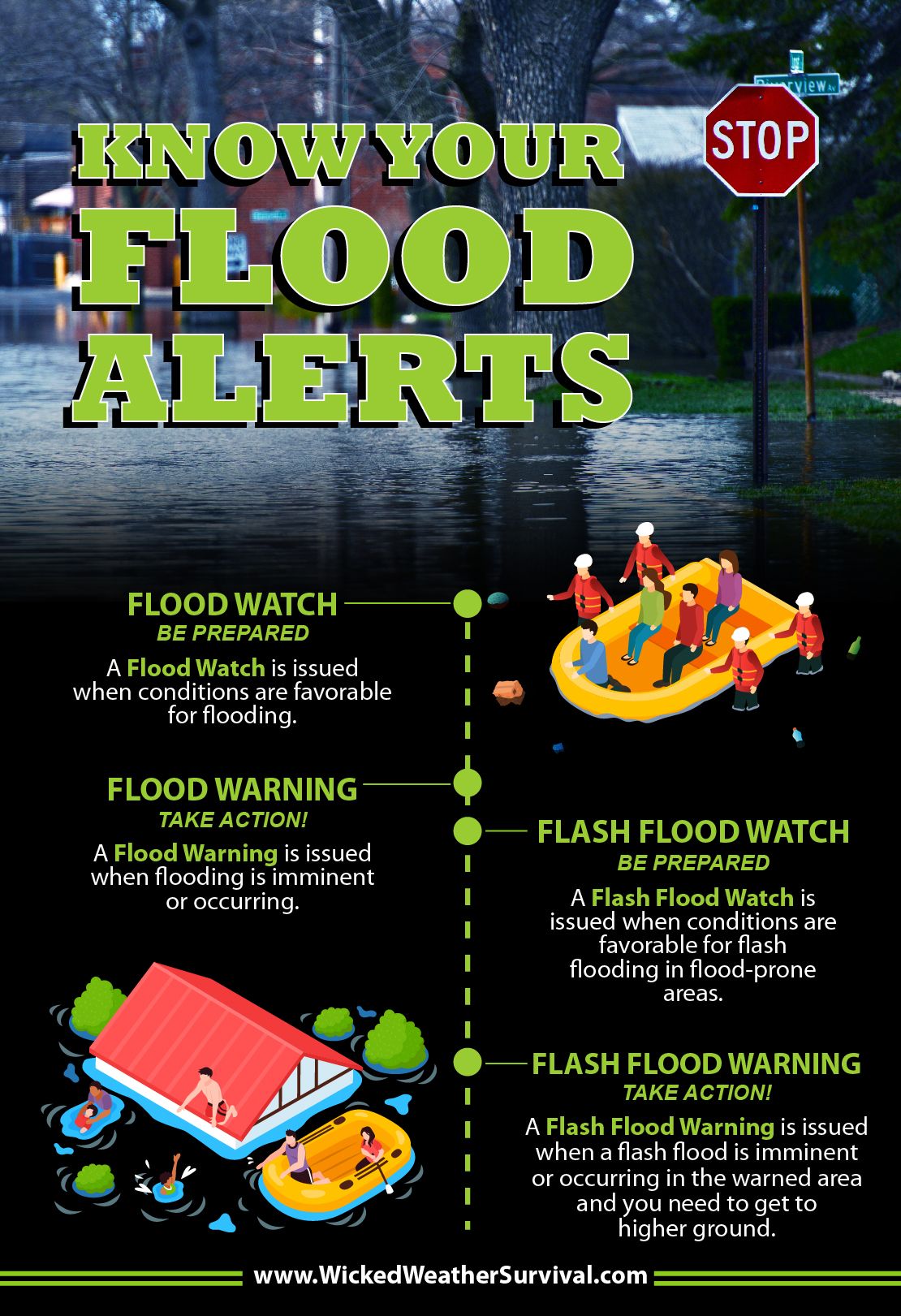Staying Safe With Flood Alerts: A Practical Guide

Table of Contents
Understanding Flood Alerts and Warnings
Knowing the difference between various types of alerts is the first step in effective flood preparedness. Understanding the urgency and implications of each alert will guide your response.
Different Types of Alerts
Several alert levels exist to inform the public about the potential for flooding. Recognizing these distinctions is key to appropriate action.
-
Flood Watch: A flood watch means conditions are favorable for flooding. Heavy rainfall, snowmelt, or dam failures are possible precursors. This is a time to prepare and monitor the situation closely. Stay informed about developing weather conditions.
-
Flood Warning: A flood warning indicates that flooding is occurring or is imminent. Immediate action is necessary. Evacuation may be required. This is a critical alert demanding immediate attention and response.
-
Flood Advisory: A flood advisory signifies that minor flooding is occurring or is expected. While less severe than a warning, it still necessitates caution and awareness. Be prepared for potential disruptions and minor inconveniences.
Sources of Flood Alerts
Staying informed requires utilizing multiple sources for flood alerts. Diversifying your information sources ensures you receive timely and accurate updates.
-
National Weather Service alerts: The National Weather Service (or your country's equivalent meteorological agency) is the primary source of official flood warnings and advisories. Sign up for their alerts via their website or mobile app.
-
Weather app alerts: Many weather apps offer customizable alerts for various weather events, including floods. Ensure your location settings are accurate.
-
Emergency alert system: Your mobile phone's emergency alert system will send alerts directly to your device in case of imminent danger, including flood warnings. Ensure that this function is enabled on your device.
-
Local news: Local news channels and websites provide up-to-date reports and information specific to your region, including detailed flood level forecasts and potential affected areas.
Interpreting Alert Information
Understanding the nuances within a flood alert is essential for effective response. Pay close attention to the specific details provided.
-
Predicted rainfall: The amount of predicted rainfall is a key indicator of potential flood severity.
-
Flood level forecast: The projected flood level helps assess the potential risk to your property and community.
-
Affected areas: Precisely understand which geographic locations are at risk to determine if you're in a danger zone.
-
Timeframe: Note the anticipated duration of the flood event to plan accordingly.
-
Specific instructions: Follow any specific instructions or recommendations included in the alert, such as evacuation orders.
Creating a Flood Preparedness Plan
Proactive planning is key to mitigating risks associated with flooding. A well-defined plan significantly improves your chances of safety and minimizes potential damage.
Developing an Evacuation Plan
Having a pre-planned evacuation route and meeting place is vital during a flood warning. This plan should be practiced regularly, particularly with children and elderly family members.
-
Multiple escape routes: Identify at least two escape routes from your home, considering potential road closures.
-
Emergency meeting place: Designate a safe meeting place outside your home where family members can gather after evacuating.
-
Emergency kit: Pack an emergency kit (detailed below) and ensure it is readily accessible.
Building an Emergency Kit
A well-stocked emergency kit is essential for survival during and after a flood.
-
Water and food: Stockpile at least three gallons of water per person per day for several days and non-perishable food items.
-
First-aid kit and medications: Include essential medications, bandages, antiseptic wipes, and pain relievers.
-
Lighting and communication: Pack a flashlight, a battery-powered radio, and extra batteries.
-
Important documents: Store vital documents, such as insurance papers and identification, in waterproof bags.
-
Other essentials: Include extra clothing, blankets, cash, and any specialized items for infants or people with disabilities.
Protecting Your Property
Taking preventative measures can significantly minimize flood damage to your property.
-
Elevate valuables: Move valuable items to higher levels of your home or store them in waterproof containers.
-
Flood barriers: Consider installing flood barriers or sandbags around your home's foundation, particularly in flood-prone areas.
-
Electrical system protection: Protect electrical systems from water damage by unplugging appliances and turning off power at the breaker box.
Responding to Flood Alerts
Swift and appropriate action is critical when a flood alert is issued. Your actions will influence the safety and security of your family and property.
Immediate Actions Upon Receiving an Alert
-
Move valuables: Immediately move valuable items, furniture, and electronics to higher ground.
-
Unplug appliances: Unplug all electrical appliances and turn off the power at the breaker box to prevent electrical hazards.
-
Monitor the situation: Continuously monitor the flood alert updates and local news reports for further instructions.
Evacuation Procedures
If an evacuation order is issued, follow these procedures immediately:
-
Designated routes: Use designated evacuation routes, avoiding flooded roads.
-
Do not drive through floodwaters: Floodwaters can be deceptively deep and fast-moving, potentially leading to vehicle damage or injury.
-
Seek higher ground: Once you’ve evacuated, seek higher ground and contact emergency services if necessary.
Post-Flood Safety
Once floodwaters recede, significant hazards remain:
-
Avoid contact with floodwater: Floodwater can be contaminated with sewage, chemicals, and other hazardous materials.
-
Report damage: Report any flood damage to local authorities and insurance companies.
-
Downed power lines: Beware of downed power lines and other hazards.
Conclusion
Staying safe during floods requires preparedness and awareness. By understanding flood alerts, creating a comprehensive plan, and taking appropriate action, you can significantly reduce your risk. Remember to regularly review your flood preparedness plan and stay updated on current flood alerts in your area. Don't be caught unprepared; take control of your safety with effective flood alert response strategies. Check your local authorities’ website for further information and resources on flood safety and preparedness in your specific region.

Featured Posts
-
 Kapan Moto Gp Argentina 2025 Tayang Di Trans7 Simak Jadwal Lengkapnya
May 26, 2025
Kapan Moto Gp Argentina 2025 Tayang Di Trans7 Simak Jadwal Lengkapnya
May 26, 2025 -
 Kapan Moto Gp Argentina 2025 Di Trans7 Jadwal Acara Lengkap
May 26, 2025
Kapan Moto Gp Argentina 2025 Di Trans7 Jadwal Acara Lengkap
May 26, 2025 -
 Follow The Monaco Grand Prix With F1 Live Timing
May 26, 2025
Follow The Monaco Grand Prix With F1 Live Timing
May 26, 2025 -
 Lewis Hamiltons Influence On F1 Rule Changes
May 26, 2025
Lewis Hamiltons Influence On F1 Rule Changes
May 26, 2025 -
 Le Silence D Elon Musk Face A La Diffusion De L Ideologie D Extreme Droite Sur X
May 26, 2025
Le Silence D Elon Musk Face A La Diffusion De L Ideologie D Extreme Droite Sur X
May 26, 2025
